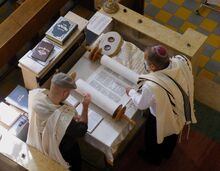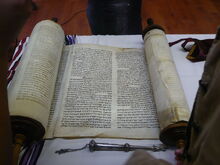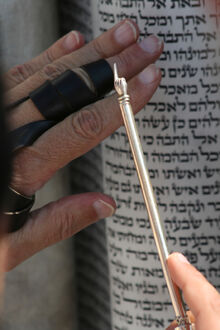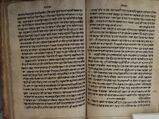Torah Reading for Saturday October 16 1952

Jewish men reading the Torah
Torah reading is a Jewish religious tradition that involves the public reading of a set of passages from a Torah scroll. The term ofttimes refers to the entire ceremony of removing the scroll (or scrolls) from the Torah ark, chanting the appropriate excerpt with special cantillation (trope), and returning the curlicue(s) to the ark.

Torah and yad
The core of festival and Shabbat prayer services is the public reading of the Torah, forth with connected readings from the other books of the Tanakh, called Haftarah. Over the course of a year, the whole Torah is read, with the cycle starting over in the autumn, on Simchat Torah.
Contents
- 1 History
- ane.1 Offset practices
- 2 Today practice
- 2.1 Hagbaha
- two.2 Aliyot
- 2.2.1 The preliminary approving
- ii.2.ii The concluding benediction
- 2.2.three Gelila
- 2.2.4 Maftir
- 2.2.5 Haftarah
- two.ii.6 Returning Torah in the ark
- iii Torah portions that are read
- 3.1 Weekly Torah portion
- 3.2 Torah reading on holidays
- 4 Simchat Torah
History [ ]
Regular public reading of the Torah was introduced past Ezra the Scribe after the render of the Judean exiles from the Babylonian captivity (c. 537 BCE), as described in the Book of Nehemiah. In the mod era, adherents of Orthodox Judaism practice Torah reading co-ordinate to a set procedure they believe has remained unchanged in the two 1000 years since the destruction of the Temple in Jerusalem (70 CE).
Torah reading is discussed in the Mishna and Talmud, primarily in tractate Megilla.
It has been suggested that the reading of the Law was due to a desire to controvert the views of the Samaritans with regard to the various festivals, for which reason arrangements were fabricated to have the passages of the Pentateuch relating to those festivals read and expounded on the feast-days themselves.
First practices [ ]

Jewish adult human being with yad
Prior to Ezra, themitzvah of Torah reading was based on the Biblical commandment ofHakhel (Deuteronomy 31:x–xiii), past which once every 7 years the entire people was to exist gathered, "men, women and children," and hear much of Deuteronomy, the concluding volume of the Pentateuch, read to them (meet the endmost chapters of the Talmudic tractate Sotah). Traditionally, themitzvah of gathering the people and reading them the Torah netherHakhel was to be performed past the King. Under Ezra, Torah reading became more frequent and the congregation themselves substituted for the King's role. Ezra is traditionally credited with initiating the modern custom of reading thrice weekly in the synagogue. This reading is an obligation incumbent on the congregation, not an individual, and did not supercede theHakhel reading past the king. The reading of the Law in the synagogue can be traced to at least about the 2nd century BCE, when the grandson of Sirach refers to it in his preface equally an Egyptian practice.
Torah reading is discussed in the Mishna and Talmud, primarily in tractate Megilla.
It has been suggested that the reading of the Constabulary was due to a desire to controvert the views of the Samaritans with regard to the various festivals, for which reason arrangements were made to have the passages of the Pentateuch relating to those festivals read and expounded on the banquet-days themselves.
Today do [ ]
The Torah whorl is stored in an ornamental cabinet, called a holy ark ('aron kodesh'), designed specifically for Torah scrolls. The Holy Ark is usually constitute in the front of the sanctuary, and is a key element of synagogue architecture. When needed for reading, the Torah is removed from the ark by someone called for the accolade from among the congregants; specific prayers are recited equally it is removed. The Torah is and so carried by the one leading the services to thebimah — a platform or table from which it will be read; further prayers are recited past the congregation while this is done.
Ikuv keriah, no longer expert, was a procedure by which community members could take their grievances addressed by interfering with the service at the fourth dimension the Torah was removed from the Ark.
Hagbaha [ ]

Sephardi human being holds up the Sephardi style Torah
In the Sefardic tradition, the Torah is lifted before the reading, and this is called "Levantar," Judeo-Spanish for להרים, to lift up, or raise. In the Yemenite tradition, the Torah remains in a resting position while simply the parchment is raised.
In Ashkenazic tradition, lifting is washed after the reading and is called "Hagbaha." Two honorees are chosen: theMagbiah ("lifter") performsHagbaha ("lifting [of the Torah]") and displays the Torah's Hebrew text for all to see, while theGolel ("roller") performsGelillah ("rolling" [of the Torah]") and puts on the encompass, belt, crown, and/or other ornaments.
Aliyot [ ]
Synagogue'south official, called agabbai, then calls up several people (men in almost Orthodox and some Conservative congregations, men and women in others, and both men and women at Reform congregations) in turn, to exist honored with analiyah (Hebrew: עליה, pl. עליותaliyot; "rise" or "going upwards"), wherein the honoree (or, more usually, a designated reader) recites a approval over the Torah, between each verse.
On Saturday mornings, there are sevenolim, the maximum of whatsoever day, merely more than may be added if desired, by subdividing these sevenaliyot or repeating passages (co-ordinate to the custom of some communities). When a festival or Yom Kippur coincides with Shabbat the readings are divided into seven aliyot instead of five or six.
In virtually congregations, theoleh does not himself read the Torah aloud. Rather, he stands near it while a practiced expert, chosen aba'al k'ri'ah ("one in charge of reading"; sometimesba'al ko're), reads the Torah, with cantillation, for the congregation. In some congregations theoleh follows along with the expert, reading in a whisper. In Yemenite communities, theoleh reads the portion himself, while another person, usually a young boy, recites the Targum later on each verse.
In both Orthodox and Conservative congregations, it is common practice to give out an aliyah to a man (or woman, in Bourgeois congregations) who has just recovered from a serious illness, or returned from a long trip, or survived another significant danger, in order to let him (or her) to recite a special approving, known every bit "benching gomel".
Aliyot are also given to a groom-to-be, or in egalitarian congregations, the bridehoped-for and groom-to-exist, together, in a pre-nuptials ceremony known as an "aufruf".
The person chosen up to read from the Torah – the summons is called an aliyah and the person so honored is called an oleh – hastens from his seat to the desk-bound, going direct to the desk-bound without whatever interruptions. Although around the world, including Northward America, many congregations will take a trained ringlet reader for the actual recitation, the very considerable honor of the reading is attributed to the oleh. If there was a previous portion read, the previous oleh then steps bated from the desk. The oleh takes his place at the desk-bound facing the open scroll, the verse where his portion begins is pointed out for him, he may kiss the scroll (usually by kissing the corner of his prayer shawl or the Torah wrapping and so touching that to the margin – not the writing – of the scroll), and then he may close his eyes, or avert his face, or otherwise signal that the blessing he is nearly to recite is not being read from the text of the Torah. While reciting the blessings he holds both handles of the gyre, and if the actual scroll reading is done by someone else, the oleh steps to the side only continues to hold with i hand i of the scroll'southward handles.
The preliminary blessing [ ]
The oleh says, preferably in a confident voice (every bit this is a call for a congregational response):
בָּרְכוּ אֶת יְיָ הַמְבֹרָךְ(Bar'chu es Adonai ham'vorach)
The congregation responds with the traditional blessingבָּרוּךְ יְיָ הַמְבֹרָךְ לְעוֹלָם וָעֶד׃(Baruch Adonai ham'vorach l'olam va'ed)
The oleh at present repeats the approval just uttered by the congregation:בָּרוּךְ יְיָ הַמְבֹרָךְ לְעוֹלָם וָעֶד
The oleh will so say:בָּרוּךְ אַתָּה יְיָ אֱלֹהֵינוּ מֶלֶךְ הָעוֹלָם׃ אֲשֶׁר בָּחַר בָּנוּ מִכָּל הָעַמִּים וְנָתַן לָנוּ אֶת תּוֹרָתוֹ׃
בָּרוּךְ אַתָּה יְיָ נוֹתֵן הַתּוֹרָה׃(Baruch atah Adonai, Eloheynu melech ha'olam.Asher bachar banu mikol ha'amim v'nosan lanu es toraso.Baruch atah Adonai, nosayn hatorah)
The concluding benediction [ ]
The portion of the Torah is and then read. If a more skilled person is doing the recitation, the oleh will follow the reading (using the whorl or a printed book) in a subdued phonation, equally will the members of the congregation.
When the portion is finished, the oleh so says the final benediction:
בָּרוּךְ אַתָּה יְיָ אֱלֹהֵינוּ מֶלֶךְ הָעוֹלָם׃ אֲשֶׁר נָתַן לָנוּ תּוֹרַת אֶמֶת׃
וְחַיֵי עוֹלָם נָטַע בְּתוֹכֵנוּ׃
בָּרוּךְ אַתָּה יְיָ נוֹתֵן הַתּוֹרָה׃(Baruch atah Adonai, Eloheynu melech ha'olam.Asher nosan lanu Toras emes.Ve'chayay olam nota besohaynu.Baruch atah Adonai, nosayn ha-torah.)
At this signal, if the oleh has recently been in danger of death (such equally serious sickness or surgery or an aeroplane flight or captivity), he will add theBirkhat HaGomel – a blessing of thanks to God "who has dealt kindly with me". The officiant may add a benediction for the oleh's proficient health, and there are some other blessings that may exist added depending on the situation. The oleh will kiss the gyre again, and may shake hands with the oleh of the previous portion, who now returns to his seat, and if there is another portion to exist read, the oleh steps aside for the next oleh, stands beside the desk while the next oleh reads his portion, shakes his hand and offers felicitation, cheers the officiant and the actual scroll reader for the honor he has received, and so returns to his seat – but slowly, as if reluctant to leave the scroll, and probably volition pause on the way to have the felicitations of various members of the congregation.
Gelila [ ]
After the reading, if the Torah is not in a wooden example, theGolel ("roller") performsGelila ("rolling up"), and so binds the Torah with a sash and replaces the Torah'south embrace. This honor is sometimes given to a child under Bar Mitzvah age.
Maftir [ ]
On days when ahaftarah is read (see Haftarah below), in that location is a finalaliyah after the kaddish, calledmaftir. The person chosen to thataliyah, as well, is known equally "themaftir." On holidays,maftir is read from the Torah verses describing the sacrifices brought in the Temple in Jerusalem on that particular holiday. In progressive synagogues alternative readings are read. On Saturday, the maftir is a repetition of the last few verses of the parsha.
When the Torah is read on the afternoon of a fast day (and on Yom Kippur), the thirdaliyah is considered the maftir, and is followed immediately by thehaftarah.
Haftarah [ ]

Haftarah
On Saturday and vacation mornings, as well equally on the afternoons of fast days and Yom Kippur, the Torah reading concludes with thehaftarah – a reading from one of the Nevi'im. Thehaftarah usually relates in some style to either the Torah reading of that mean solar day, a theme of the holiday, or the time of year.
Returning Torah in the ark [ ]
The Torah roll is and so put back in its ark to the accompaniment of specific prayers.
The Chazzan takes the Torah whorl in his right arm and recites "Let them praise the name of HaShem, for his name alone will have been exalted." The congregation then responds with Psalm 148, verses 13–14.
Torah portions that are read [ ]
Weekly Torah portion [ ]
Information technology is a custom among religious Jewish communities for aweekly Torah portion, popularly referred to as aparashah, to exist read during Jewish prayer services on Saturdays, Mondays and Thursdays. The parashah is a section of the Torah used in Jewish liturgy during a particular week. There are 54 weekly parshas, orparashiyot in Hebrew, and the full bike is read over the form of ane Jewish year.
The advisable parashah is chanted publicly past a designated reader (ba'al koreh) in Jewish prayer services, starting with a partial reading on the afternoon of Shabbat, the Jewish Sabbath, i.e. Saturday afternoon, again during the Monday and Th morning services, and ending with a full reading during the following Shabbat morning services (Saturday forenoon).
Torah reading on holidays [ ]
On Jewish holidays, the reading relates to the mean solar day. For example, on Pesach the congregation reads various sections of the Torah that relate to that vacation.
When multiple special occasions occur at the same time, there is a standard social club of precedence. Generally speaking, when major Jewish holidays occur on Shabbat the vacation portion is read, although divided into the seven portions for Shabbat rather than the number advisable for the holiday — at that place is a special reading for when Shabbat coincides with the Chol HaMoed (intermediate days) of Pesach or Sukkot.
However, when Shabbat coincides with pocket-size holidays, such as Rosh Chodesh (New month) or Hanukkah, the regular reading for Shabbat is read, plus an boosted reading (maftir) relevant to the occasion. The boosted reading is read from a second scroll if available.
On rare occasions, such equally when a Rosh Chodesh falls on a Shabbat that as well commemorates some other occasion, such every bit Hanukkah or when 1 of the four special additional readings read prior to Pesach, there are ii boosted readings and iii scrolls (if available) are read.
Simchat Torah [ ]
Main article:Simchat Torah

Torah scroll and yad
Simchat Torah is a Jewish vacation that celebrates and marks the conclusion of the almanac cycle of public Torah readings, and the beginning of a new cycle.
On Simchat Torah (Hebrew: שמחת תורה, "Joyous celebration of the Torah"), the order of weekly readings is completed, and the mean solar day is historic with various customs involving the Torah. The Torah is read at night – a unique occurrence, preceded by seven rounds of vocal and dance (hakafot, sing.hakafah; some communities takehakafot without afterwards reading the Torah.) During thehakafot, almost or all of the synagogue's Torah scrolls are removed from the Holy Ark, and carried around the Bimah by members of the congregation.
On the day of Simchat Torah , some communities repeat the seven rounds of vocal and dance to varying degrees, while in others the Torah scrolls are only carried effectually the Bimah (7 times) symbolically. Afterwards, many communities have the custom of calling every member of the congregation for analiyah, which is accomplished by repeatedly re-reading the day's fivealiyot. The process is often expedited by splitting the congregants into multiple rooms, to each of which a Torah is brought for the reading.
Following the regularaliyot, the honor ofHatan Torah ("Groom of the Torah") is given to a distinguished fellow member of the congregation, who is called for analiyah in which the remaining verses of the Torah are read, to complete that year's reading.
Another member of the congregation is honored withHatan Bereishit ("Groom of Bereshit"), and receives analiyah in which the first verses of the Torah, containing the creation account of Genesis, are read (a second copy of the Torah is usually used, so that the showtime demand not exist rolled all the way to the beginning while the congregants wait).
Afterwards, the services proceed in the usual manner, with the maftir and the haftarah for Simchat Torah.
Torah Reading for Saturday October 16 1952
Source: https://unnaturalworld.fandom.com/wiki/Torah_reading